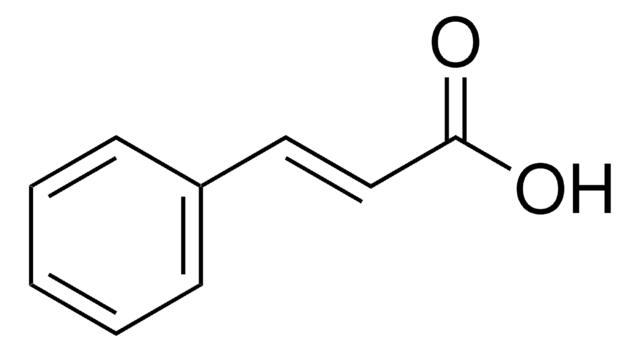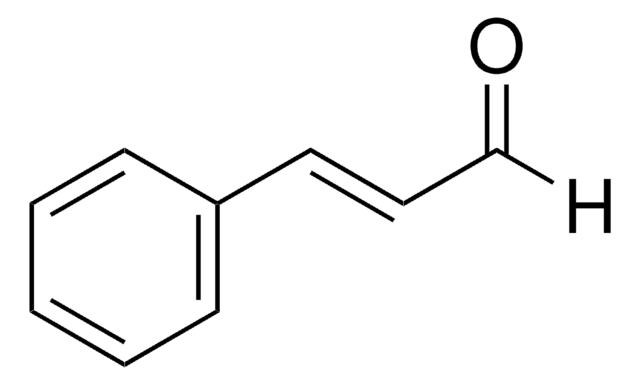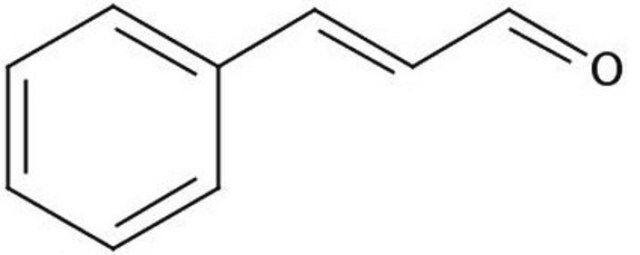06536
trans-Cinnamaldehyde
analytical standard
Sinonimo/i:
trans-3-Phenyl-2-propenal
About This Item
Prodotti consigliati
Grado
analytical standard
Livello qualitativo
Densità del vapore
4.6 (vs air)
Saggio
≥95.0% (GC)
Durata
limited shelf life, expiry date on the label
tecniche
HPLC: suitable
gas chromatography (GC): suitable
Indice di rifrazione
n20/D 1.622 (lit.)
P. ebollizione
250-252 °C (lit.)
Punto di fusione
−9-−4 °C (lit.)
Densità
1.05 g/mL at 25 °C (lit.)
applicazioni
cleaning products
cosmetics
flavors and fragrances
food and beverages
personal care
Formato
neat
Temperatura di conservazione
2-8°C
Stringa SMILE
[H]C(=O)\C=C\c1ccccc1
InChI
1S/C9H8O/c10-8-4-7-9-5-2-1-3-6-9/h1-8H/b7-4+
KJPRLNWUNMBNBZ-QPJJXVBHSA-N
Cerchi prodotti simili? Visita Guida al confronto tra prodotti
Applicazioni
- Pharmacological Activity in Metabolic Diseases: Cinnamaldehyde is investigated for its potential to attenuate diabetic osteoporosis in a rat model, mediated through the modulation of the netrin-1/DCC-UNC5B signaling pathway. This suggests its applicability in therapeutic strategies against metabolic bone diseases (Ji et al., 2024).
- Antibacterial and Biofilm Inhibition: The study reviews the inhibitory effects of natural compounds, including cinnamaldehyde, on the quorum sensing systems of Pseudomonas aeruginosa. This indicates its potential role in managing biofilm communities, which could be crucial for developing new antibacterial strategies (Shariati et al., 2024).
Confezionamento
Altre note
Avvertenze
Warning
Indicazioni di pericolo
Consigli di prudenza
Classi di pericolo
Eye Irrit. 2 - Skin Irrit. 2 - Skin Sens. 1 - STOT SE 3
Organi bersaglio
Respiratory system
Codice della classe di stoccaggio
10 - Combustible liquids
Classe di pericolosità dell'acqua (WGK)
WGK 3
Punto d’infiammabilità (°F)
159.8 °F - closed cup
Punto d’infiammabilità (°C)
71 °C - closed cup
Scegli una delle versioni più recenti:
Certificati d'analisi (COA)
Non trovi la versione di tuo interesse?
Se hai bisogno di una versione specifica, puoi cercare il certificato tramite il numero di lotto.
Possiedi già questo prodotto?
I documenti relativi ai prodotti acquistati recentemente sono disponibili nell’Archivio dei documenti.
I clienti hanno visto anche
Il team dei nostri ricercatori vanta grande esperienza in tutte le aree della ricerca quali Life Science, scienza dei materiali, sintesi chimica, cromatografia, discipline analitiche, ecc..
Contatta l'Assistenza Tecnica.









